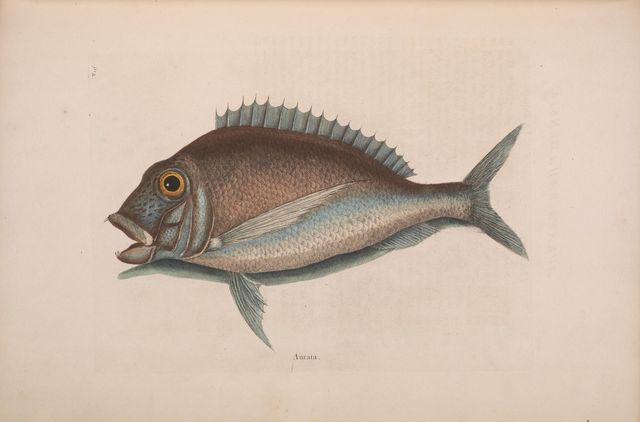What Is Porgy?
When it comes to eating fish in this country, people have pretty limited imaginations. Salmon, tuna and shrimp represent more than half of all seafood consumed, and some 85 percent of the fish we eat is imported (including what's fished here but sent to China for processing). Now that genetically modified salmon is coming to a fishmonger near you, it might be time to broaden your aquatic horizons. Food Republic wants to help you achieve this goal with a new series on lesser-known fish species that are delicious and plentiful in our otherwise fiercely plundered oceans.
To those of us who are not fishermen (or fish), it might not be immediately obvious that a hierarchy exists among the different types of catch. In Montauk, for example, porgy is often what you get when you're trying to catch fluke or bass — and you fail. It's a relatively slow swimmer, easy to catch, and thus has long played second fiddle to its better-known ocean brethren. These days, thanks to a handful of chefs singing its praises, plus new efforts to fish and eat sustainably, the underappreciated porgy is finally getting its due.
"Porgy gets a bad rap," says Todd Mitgang, chef and partner at Crave Fishbar in New York City. The Nassau County native has defiantly kept porgy on the menu at Crave––both the original in midtown and the Upper West Side outpost that opened in December––as well as at his Montauk seafood shack, South Edison, since the places opened.
"Porgies are easily caught. They tend to be small, and they don't put up a fight. And they're abundant, so if you're out on the water trying to catch anything but a porgy, you're gonna catch a porgy," Mitgang explains, adding that fishing boat captains have long used them as bait.
Native to the Atlantic Ocean, several species fall under the umbrella of what gets called porgy. Scup, sea bream and sheepshead are all part of the Sparidae family. The research done on porgy tends to refer to scup: Stenotomus chrysops. It's a staple of Northeast fisheries: Some 4.3 million pounds of porgy were caught in 2012, representing more than $3.5 million in revenue in New York state. The introduction of trawl fishing in the first half of the 20th century eventually hurt porgy populations. Overfishing of more coveted species, like fluke and bass, also impacted the species. As a bycatch, it too was depleted, and was declared overfished in 2005. Today, however, as fishing practices have improved, porgy populations are on the rise.
Mitgang started featuring porgy on the menu back when he first opened South Edison because, he says, "that's what the docks were giving us." In recent years, other chefs have boarded the porgy bandwagon, making it something of a trendy fish — insomuch as a fish can trend. Still, Mitgang admits, even in his pro-porgy restaurants, the species once relegated to lowly bycatch does not sell as well as tuna or salmon.
"For me, it's the red snapper of the Northeast," says Captain Rick Lofstad, a third-generation fisherman on Long Island, whose grandfather, a whaler, emigrated from Norway. Lofstad's Pura Vida Fisheries peddles its catch in a number of the New York area's farmers' markets. "Everybody knows red snapper — well, there's no difference in texture or taste."
Porgy is a white-fleshed fish, medium-fatty — not too lean, not too oily — with a sweet, delicate flavor and edible skin. It shines in a variety of preparations; Crave is now doing it as a crudo. What's more, it offers a good value compared to similar but better-known varieties. Yet beyond foodie circles, porgy still struggles with a bad reputation. According to Lofstad, one of the problems it faces is American consumers' preference for skinless, boneless fillets. Porgies are usually sold whole.
It's also known for being bony, although the claim is exaggerated at best. Since quotas were put in place in the 1990s and recent evidence showed its populations bouncing back, fishermen have reported that the fish themselves are bigger nowadays. According to Seafood Watch, the go-to source for fish sustainability, it's always a good sign when not only are a species' numbers up but the range of sizes also increases. The organization now has porgy on the yellow list: a good alternative. A good deal more research is required before it makes the green "Best Choices" list, but the outlook is positive.
"I tell people all the time: 'Eat porgy,'" says Sheila Bowman, Seafood Watch's manager of culinary and strategic initiatives. "What we do is try to get chefs excited about this 'trash fish' concept, that so-called throwaway fish can be delicious. It doesn't always work. Sometimes we have a fish with a good story, but the product just doesn't hold up culinarily. But with porgy, it does. It's a good story and a good fish."
Porgy Poke by Chef Todd Mitgang, Crave Fish Bar
(serves 4)
Ingredients:For the dressing:
1 cup Tamari soy sauce
1 1⁄2 cups cold water
1 1⁄2 tsp hot sesame oil
2 tbsp aged sherry vinegar
In a mixing bowl, whisk all ingredients together.
For the porgy:
8 oz. fresh skinned and cubed porgy
1⁄2 cup cubed Persian cucumbers
1 tbsp toasted sesame seeds
2 tbsp candied macadamia nuts (or any candied nut)
2 tbsp thinly sliced scallion
1⁄4 cup popped rice, like Rice Krispies
2 oz. micro basil (or any fresh herb), for garnish
Extra-virgin olive oil, for garnish
Toss porgy with dressing, cucumbers and scallions. In 4 separate bowls, sprinkle one layer of popped rice at the bottom, then top with porgy, cucumber and scallion mixture. Add sesame seeds and candied macadamia nuts. Finish with olive oil and micro basil.


